International Trade Economics Report: Openness, Inequality, and Trade
VerifiedAdded on 2022/09/29
|7
|1049
|26
Report
AI Summary
This economics report examines the relationship between openness and industry pay inequality, focusing on Australia and Singapore. The analysis includes correlation estimations to understand the extent of the relationship between trade and wage inequality, with findings indicating a positive correlation between openness and industry pay inequality in both countries, though the relationship is weaker in Singapore. The report then applies the Stolper-Samuelson Theorem to explain how changes in output prices affect factor prices, particularly the wages of skilled and unskilled labor. The study supports the theorem, suggesting that increased participation in international trade leads to higher wages for skilled workers, reflecting the intensive use of skilled labor in the production of exported goods. The analysis is supported by data on trade, GDP, and industrial pay inequality, providing insights into the impact of free trade on labor markets.
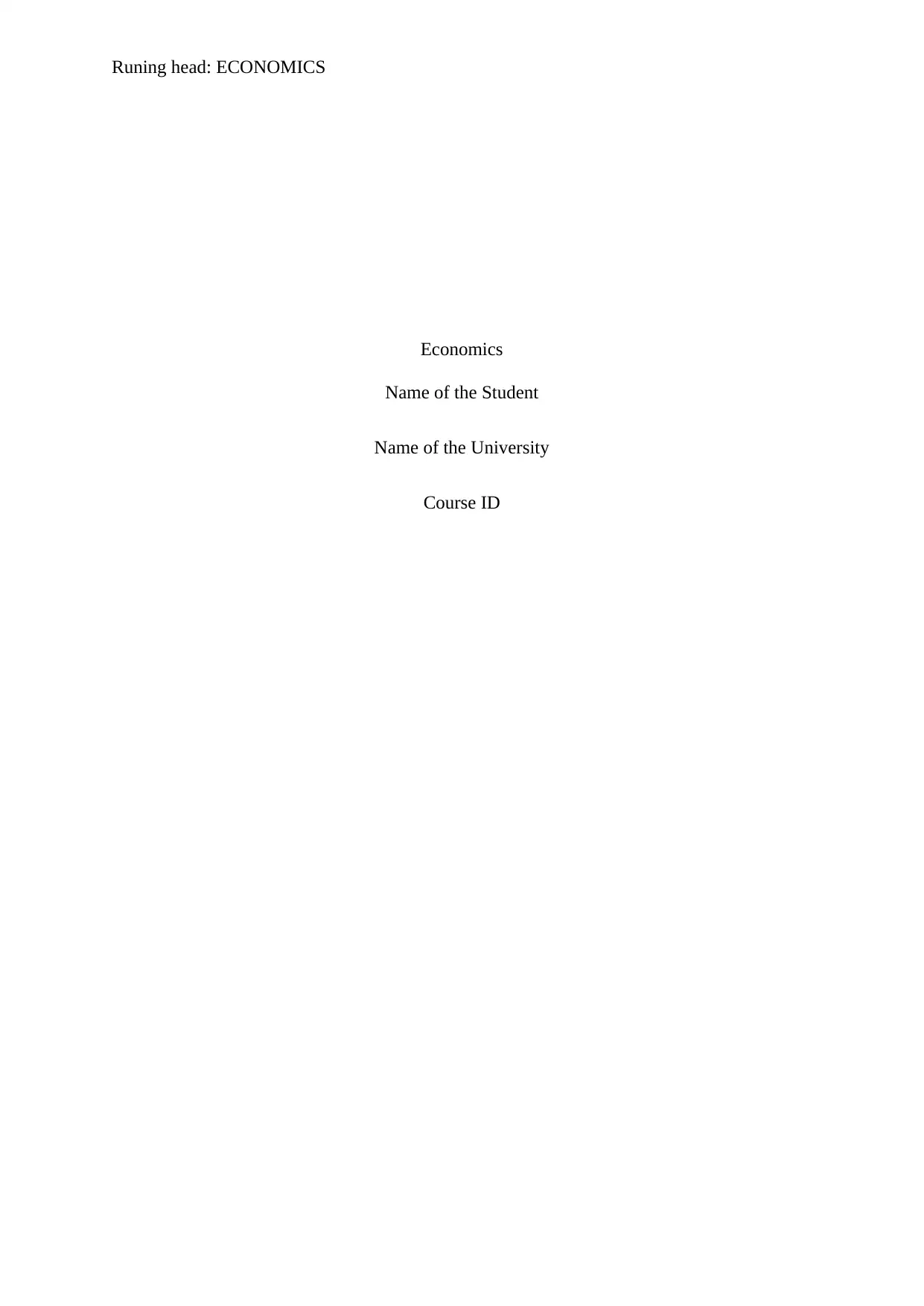
Runing head: ECONOMICS
Economics
Name of the Student
Name of the University
Course ID
Economics
Name of the Student
Name of the University
Course ID
Paraphrase This Document
Need a fresh take? Get an instant paraphrase of this document with our AI Paraphraser
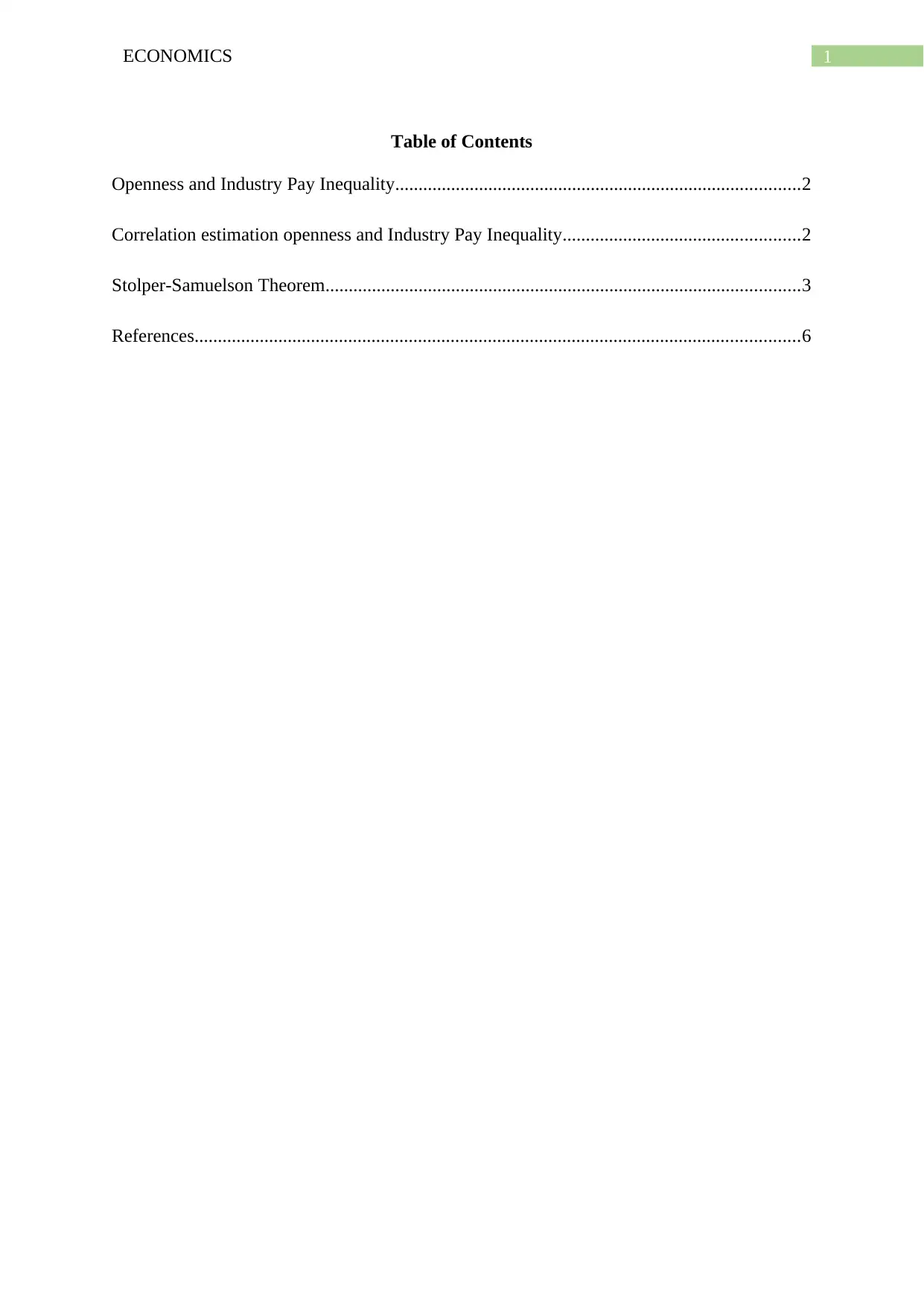
1ECONOMICS
Table of Contents
Openness and Industry Pay Inequality.......................................................................................2
Correlation estimation openness and Industry Pay Inequality...................................................2
Stolper-Samuelson Theorem......................................................................................................3
References..................................................................................................................................6
Table of Contents
Openness and Industry Pay Inequality.......................................................................................2
Correlation estimation openness and Industry Pay Inequality...................................................2
Stolper-Samuelson Theorem......................................................................................................3
References..................................................................................................................................6
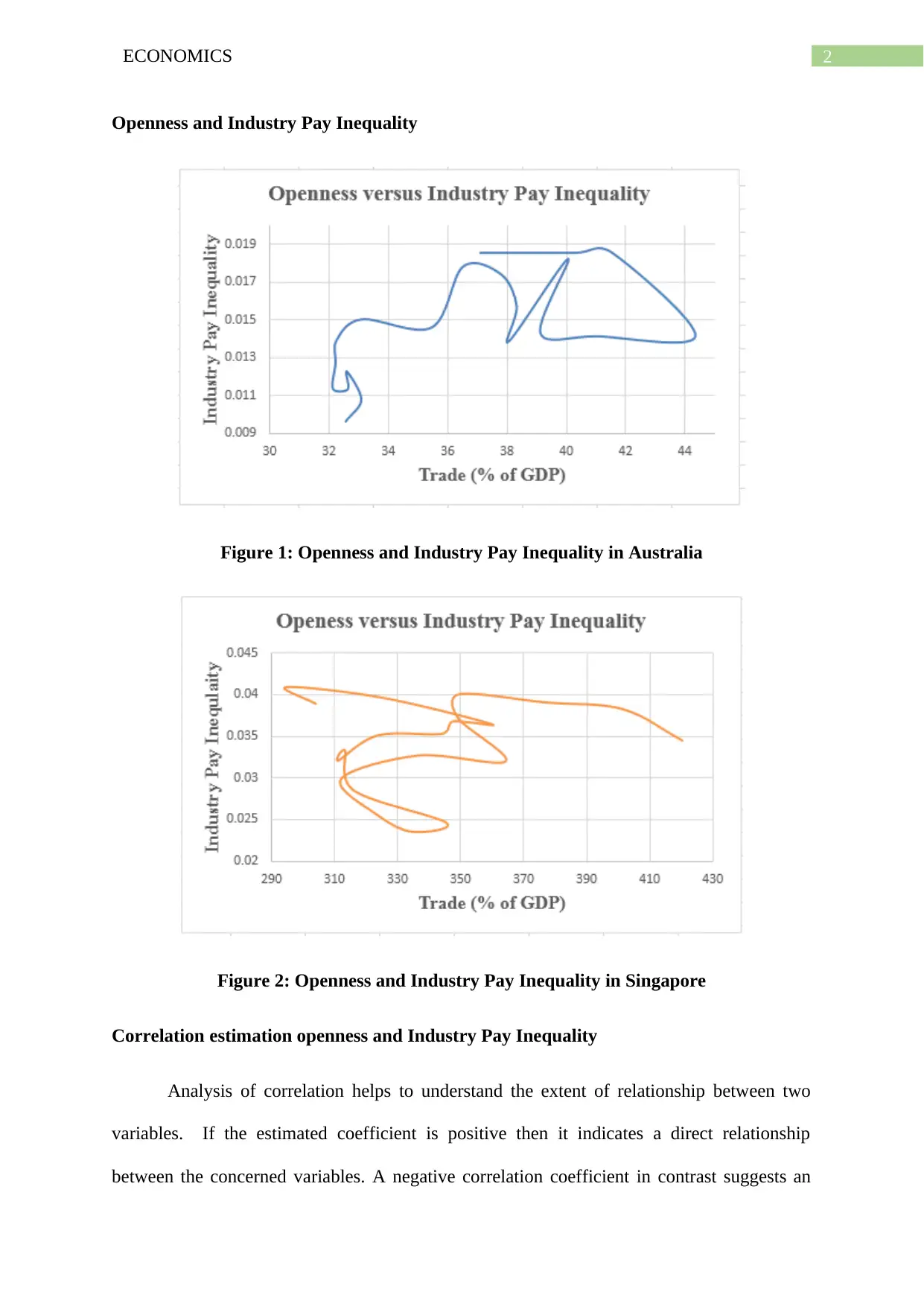
2ECONOMICS
Openness and Industry Pay Inequality
Figure 1: Openness and Industry Pay Inequality in Australia
Figure 2: Openness and Industry Pay Inequality in Singapore
Correlation estimation openness and Industry Pay Inequality
Analysis of correlation helps to understand the extent of relationship between two
variables. If the estimated coefficient is positive then it indicates a direct relationship
between the concerned variables. A negative correlation coefficient in contrast suggests an
Openness and Industry Pay Inequality
Figure 1: Openness and Industry Pay Inequality in Australia
Figure 2: Openness and Industry Pay Inequality in Singapore
Correlation estimation openness and Industry Pay Inequality
Analysis of correlation helps to understand the extent of relationship between two
variables. If the estimated coefficient is positive then it indicates a direct relationship
between the concerned variables. A negative correlation coefficient in contrast suggests an
⊘ This is a preview!⊘
Do you want full access?
Subscribe today to unlock all pages.

Trusted by 1+ million students worldwide
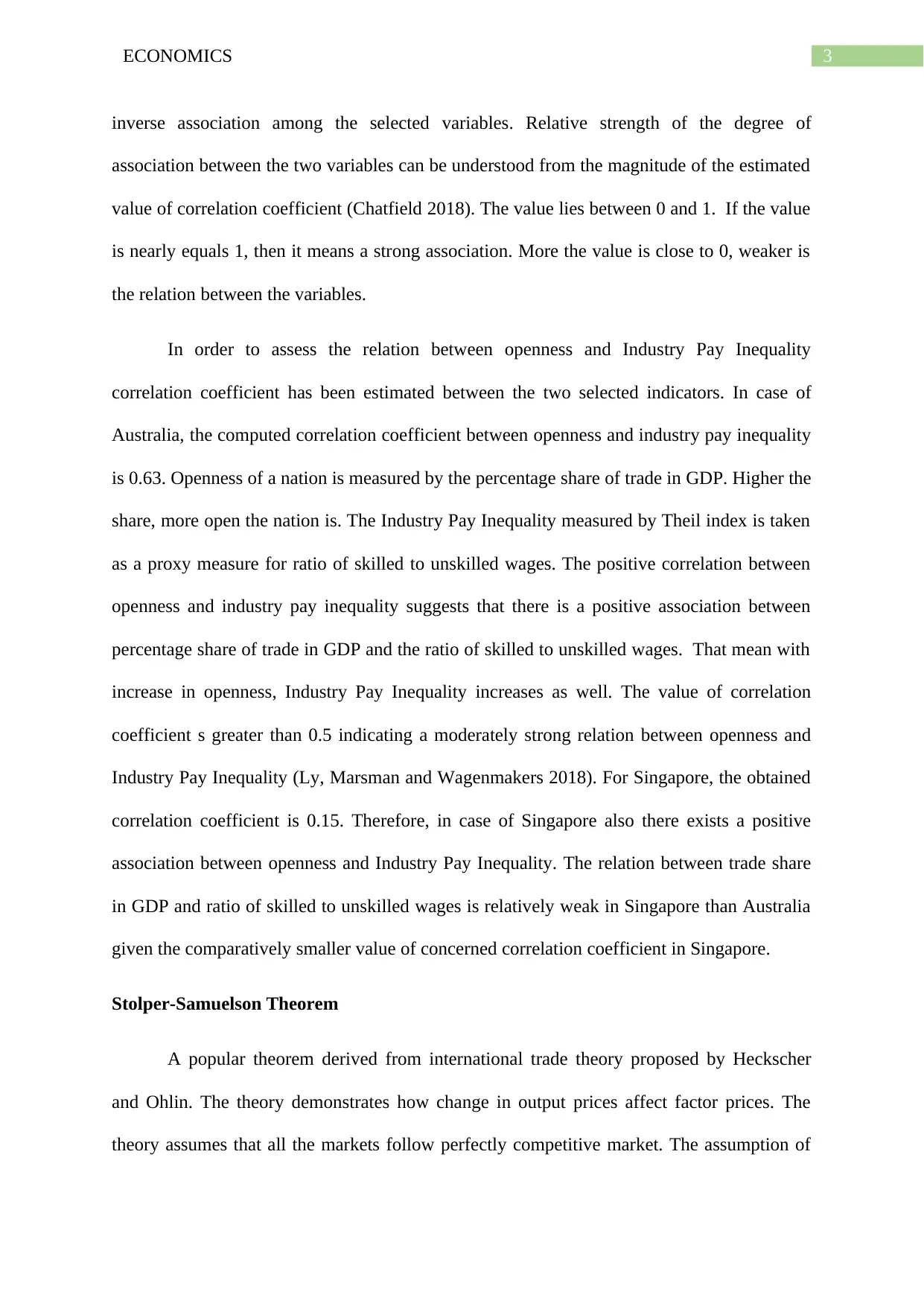
3ECONOMICS
inverse association among the selected variables. Relative strength of the degree of
association between the two variables can be understood from the magnitude of the estimated
value of correlation coefficient (Chatfield 2018). The value lies between 0 and 1. If the value
is nearly equals 1, then it means a strong association. More the value is close to 0, weaker is
the relation between the variables.
In order to assess the relation between openness and Industry Pay Inequality
correlation coefficient has been estimated between the two selected indicators. In case of
Australia, the computed correlation coefficient between openness and industry pay inequality
is 0.63. Openness of a nation is measured by the percentage share of trade in GDP. Higher the
share, more open the nation is. The Industry Pay Inequality measured by Theil index is taken
as a proxy measure for ratio of skilled to unskilled wages. The positive correlation between
openness and industry pay inequality suggests that there is a positive association between
percentage share of trade in GDP and the ratio of skilled to unskilled wages. That mean with
increase in openness, Industry Pay Inequality increases as well. The value of correlation
coefficient s greater than 0.5 indicating a moderately strong relation between openness and
Industry Pay Inequality (Ly, Marsman and Wagenmakers 2018). For Singapore, the obtained
correlation coefficient is 0.15. Therefore, in case of Singapore also there exists a positive
association between openness and Industry Pay Inequality. The relation between trade share
in GDP and ratio of skilled to unskilled wages is relatively weak in Singapore than Australia
given the comparatively smaller value of concerned correlation coefficient in Singapore.
Stolper-Samuelson Theorem
A popular theorem derived from international trade theory proposed by Heckscher
and Ohlin. The theory demonstrates how change in output prices affect factor prices. The
theory assumes that all the markets follow perfectly competitive market. The assumption of
inverse association among the selected variables. Relative strength of the degree of
association between the two variables can be understood from the magnitude of the estimated
value of correlation coefficient (Chatfield 2018). The value lies between 0 and 1. If the value
is nearly equals 1, then it means a strong association. More the value is close to 0, weaker is
the relation between the variables.
In order to assess the relation between openness and Industry Pay Inequality
correlation coefficient has been estimated between the two selected indicators. In case of
Australia, the computed correlation coefficient between openness and industry pay inequality
is 0.63. Openness of a nation is measured by the percentage share of trade in GDP. Higher the
share, more open the nation is. The Industry Pay Inequality measured by Theil index is taken
as a proxy measure for ratio of skilled to unskilled wages. The positive correlation between
openness and industry pay inequality suggests that there is a positive association between
percentage share of trade in GDP and the ratio of skilled to unskilled wages. That mean with
increase in openness, Industry Pay Inequality increases as well. The value of correlation
coefficient s greater than 0.5 indicating a moderately strong relation between openness and
Industry Pay Inequality (Ly, Marsman and Wagenmakers 2018). For Singapore, the obtained
correlation coefficient is 0.15. Therefore, in case of Singapore also there exists a positive
association between openness and Industry Pay Inequality. The relation between trade share
in GDP and ratio of skilled to unskilled wages is relatively weak in Singapore than Australia
given the comparatively smaller value of concerned correlation coefficient in Singapore.
Stolper-Samuelson Theorem
A popular theorem derived from international trade theory proposed by Heckscher
and Ohlin. The theory demonstrates how change in output prices affect factor prices. The
theory assumes that all the markets follow perfectly competitive market. The assumption of
Paraphrase This Document
Need a fresh take? Get an instant paraphrase of this document with our AI Paraphraser
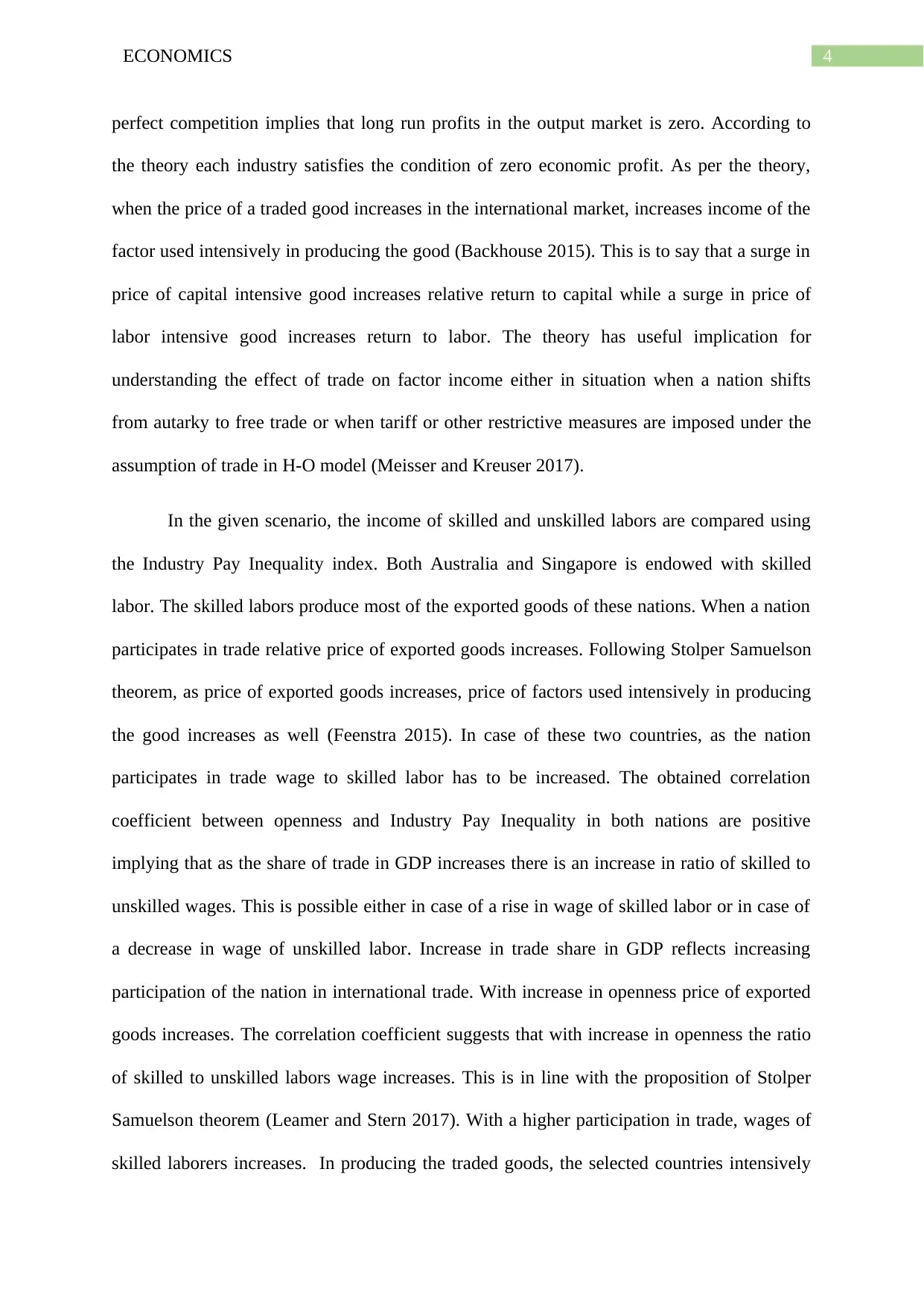
4ECONOMICS
perfect competition implies that long run profits in the output market is zero. According to
the theory each industry satisfies the condition of zero economic profit. As per the theory,
when the price of a traded good increases in the international market, increases income of the
factor used intensively in producing the good (Backhouse 2015). This is to say that a surge in
price of capital intensive good increases relative return to capital while a surge in price of
labor intensive good increases return to labor. The theory has useful implication for
understanding the effect of trade on factor income either in situation when a nation shifts
from autarky to free trade or when tariff or other restrictive measures are imposed under the
assumption of trade in H-O model (Meisser and Kreuser 2017).
In the given scenario, the income of skilled and unskilled labors are compared using
the Industry Pay Inequality index. Both Australia and Singapore is endowed with skilled
labor. The skilled labors produce most of the exported goods of these nations. When a nation
participates in trade relative price of exported goods increases. Following Stolper Samuelson
theorem, as price of exported goods increases, price of factors used intensively in producing
the good increases as well (Feenstra 2015). In case of these two countries, as the nation
participates in trade wage to skilled labor has to be increased. The obtained correlation
coefficient between openness and Industry Pay Inequality in both nations are positive
implying that as the share of trade in GDP increases there is an increase in ratio of skilled to
unskilled wages. This is possible either in case of a rise in wage of skilled labor or in case of
a decrease in wage of unskilled labor. Increase in trade share in GDP reflects increasing
participation of the nation in international trade. With increase in openness price of exported
goods increases. The correlation coefficient suggests that with increase in openness the ratio
of skilled to unskilled labors wage increases. This is in line with the proposition of Stolper
Samuelson theorem (Leamer and Stern 2017). With a higher participation in trade, wages of
skilled laborers increases. In producing the traded goods, the selected countries intensively
perfect competition implies that long run profits in the output market is zero. According to
the theory each industry satisfies the condition of zero economic profit. As per the theory,
when the price of a traded good increases in the international market, increases income of the
factor used intensively in producing the good (Backhouse 2015). This is to say that a surge in
price of capital intensive good increases relative return to capital while a surge in price of
labor intensive good increases return to labor. The theory has useful implication for
understanding the effect of trade on factor income either in situation when a nation shifts
from autarky to free trade or when tariff or other restrictive measures are imposed under the
assumption of trade in H-O model (Meisser and Kreuser 2017).
In the given scenario, the income of skilled and unskilled labors are compared using
the Industry Pay Inequality index. Both Australia and Singapore is endowed with skilled
labor. The skilled labors produce most of the exported goods of these nations. When a nation
participates in trade relative price of exported goods increases. Following Stolper Samuelson
theorem, as price of exported goods increases, price of factors used intensively in producing
the good increases as well (Feenstra 2015). In case of these two countries, as the nation
participates in trade wage to skilled labor has to be increased. The obtained correlation
coefficient between openness and Industry Pay Inequality in both nations are positive
implying that as the share of trade in GDP increases there is an increase in ratio of skilled to
unskilled wages. This is possible either in case of a rise in wage of skilled labor or in case of
a decrease in wage of unskilled labor. Increase in trade share in GDP reflects increasing
participation of the nation in international trade. With increase in openness price of exported
goods increases. The correlation coefficient suggests that with increase in openness the ratio
of skilled to unskilled labors wage increases. This is in line with the proposition of Stolper
Samuelson theorem (Leamer and Stern 2017). With a higher participation in trade, wages of
skilled laborers increases. In producing the traded goods, the selected countries intensively
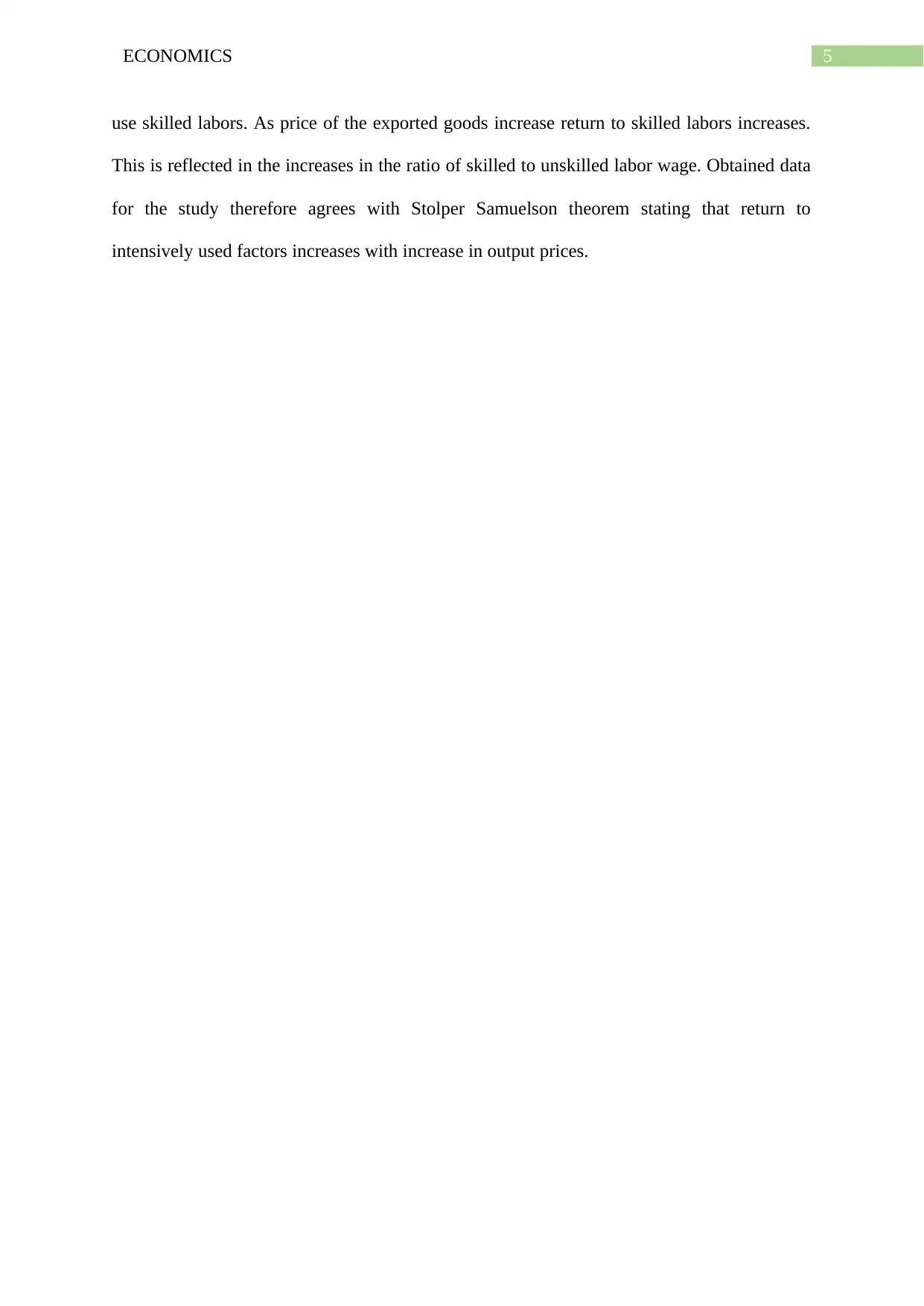
5ECONOMICS
use skilled labors. As price of the exported goods increase return to skilled labors increases.
This is reflected in the increases in the ratio of skilled to unskilled labor wage. Obtained data
for the study therefore agrees with Stolper Samuelson theorem stating that return to
intensively used factors increases with increase in output prices.
use skilled labors. As price of the exported goods increase return to skilled labors increases.
This is reflected in the increases in the ratio of skilled to unskilled labor wage. Obtained data
for the study therefore agrees with Stolper Samuelson theorem stating that return to
intensively used factors increases with increase in output prices.
⊘ This is a preview!⊘
Do you want full access?
Subscribe today to unlock all pages.

Trusted by 1+ million students worldwide
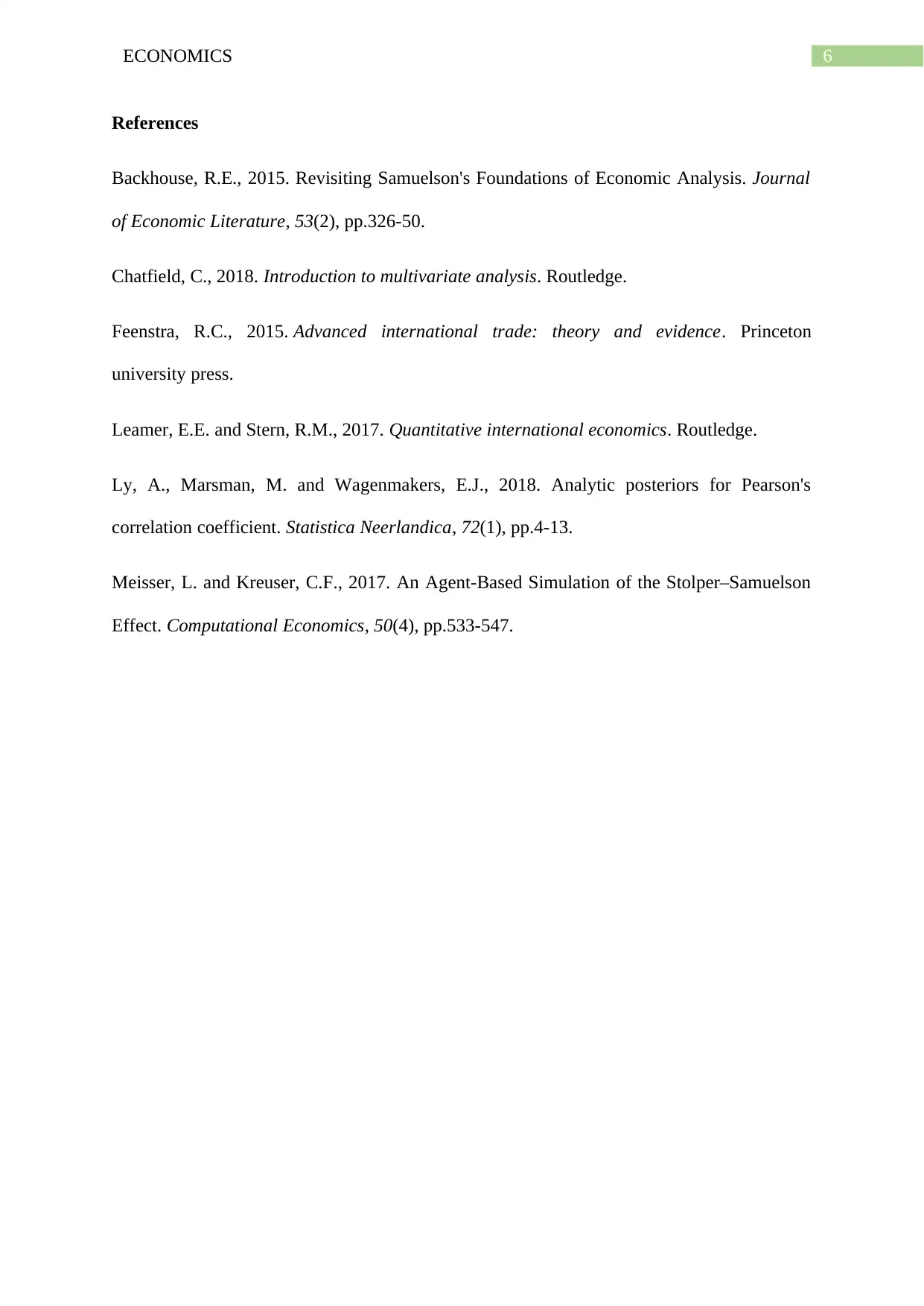
6ECONOMICS
References
Backhouse, R.E., 2015. Revisiting Samuelson's Foundations of Economic Analysis. Journal
of Economic Literature, 53(2), pp.326-50.
Chatfield, C., 2018. Introduction to multivariate analysis. Routledge.
Feenstra, R.C., 2015. Advanced international trade: theory and evidence. Princeton
university press.
Leamer, E.E. and Stern, R.M., 2017. Quantitative international economics. Routledge.
Ly, A., Marsman, M. and Wagenmakers, E.J., 2018. Analytic posteriors for Pearson's
correlation coefficient. Statistica Neerlandica, 72(1), pp.4-13.
Meisser, L. and Kreuser, C.F., 2017. An Agent-Based Simulation of the Stolper–Samuelson
Effect. Computational Economics, 50(4), pp.533-547.
References
Backhouse, R.E., 2015. Revisiting Samuelson's Foundations of Economic Analysis. Journal
of Economic Literature, 53(2), pp.326-50.
Chatfield, C., 2018. Introduction to multivariate analysis. Routledge.
Feenstra, R.C., 2015. Advanced international trade: theory and evidence. Princeton
university press.
Leamer, E.E. and Stern, R.M., 2017. Quantitative international economics. Routledge.
Ly, A., Marsman, M. and Wagenmakers, E.J., 2018. Analytic posteriors for Pearson's
correlation coefficient. Statistica Neerlandica, 72(1), pp.4-13.
Meisser, L. and Kreuser, C.F., 2017. An Agent-Based Simulation of the Stolper–Samuelson
Effect. Computational Economics, 50(4), pp.533-547.
1 out of 7
Related Documents
Your All-in-One AI-Powered Toolkit for Academic Success.
+13062052269
info@desklib.com
Available 24*7 on WhatsApp / Email
![[object Object]](/_next/static/media/star-bottom.7253800d.svg)
Unlock your academic potential
Copyright © 2020–2025 A2Z Services. All Rights Reserved. Developed and managed by ZUCOL.





